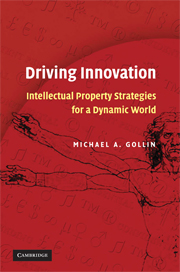Book contents
- Frontmatter
- Contents
- Foreword
- Preface
- Acknowledgments
- Abbreviations
- Introduction: The Invisible Infrastructure of Innovation
- PART I INTELLECTUAL PROPERTY DYNAMICS IN SOCIETY
- PART II BASICS OF MANAGING INTELLECTUAL PROPERTY IN ORGANIZATIONS
- 4 The Innovation Tree: Intellectual Property Rights and How They Grow
- 5 The ABCDs of Intellectual Property: Flow and Infringement of Rights
- 6 The Role of Communities in Innovation
- 7 The Innovation Chief
- PART III STEPS TO STRATEGIC MANAGEMENT OF INTELLECTUAL PROPERTY
- PART IV STRATEGIES ON A GLOBAL STAGE
- APPENDIX A Excerpts from TRIPS Agreement
- APPENDIX B Intellectual Property Non-Policy
- APPENDIX C Intellectual Property Assessment Questionnaire
- APPENDIX D Research Tools for Obtaining Intellectual Property Information
- Bibliography
- Index
5 - The ABCDs of Intellectual Property: Flow and Infringement of Rights
Published online by Cambridge University Press: 05 June 2012
- Frontmatter
- Contents
- Foreword
- Preface
- Acknowledgments
- Abbreviations
- Introduction: The Invisible Infrastructure of Innovation
- PART I INTELLECTUAL PROPERTY DYNAMICS IN SOCIETY
- PART II BASICS OF MANAGING INTELLECTUAL PROPERTY IN ORGANIZATIONS
- 4 The Innovation Tree: Intellectual Property Rights and How They Grow
- 5 The ABCDs of Intellectual Property: Flow and Infringement of Rights
- 6 The Role of Communities in Innovation
- 7 The Innovation Chief
- PART III STEPS TO STRATEGIC MANAGEMENT OF INTELLECTUAL PROPERTY
- PART IV STRATEGIES ON A GLOBAL STAGE
- APPENDIX A Excerpts from TRIPS Agreement
- APPENDIX B Intellectual Property Non-Policy
- APPENDIX C Intellectual Property Assessment Questionnaire
- APPENDIX D Research Tools for Obtaining Intellectual Property Information
- Bibliography
- Index
Summary
This chapter gives a broad conceptual overview of the transfer of intellectual property from A to B to C to D, and how it relates to the innovation cycle. The summary includes the types of rights that can flow, how they can be transferred in whole, or in part, and the nature of joint works and collaborations. Transfer of IP rights provides users of innovations with sufficient permission for their activities. Infringement can be understood as an absence of such permissions. Liability for infringement can flow in a similar fashion to the flow of IP rights. The topics of this chapter are revisited in Chapters 14 and 15.
In a broad sense, laws in most countries treat the various types of intellectual property rights like any other type of property – land, buildings, lumber, crops, electronics, cars, money, or stock certificates. That is, people can buy or sell intellectual property, use it, profit from it, and exclude others from using it. However, the transfer and flow of intellectual property has its own general rules, and each particular intellectual property “tree” has its peculiarities.
The transfer of ideas from creator to developer to consumer is a complex process that is crucial to how the innovation cycle operates. The channels of distribution for the rights may be commercial markets, or noncommercial channels such as educational, academic, or governmental agencies.
- Type
- Chapter
- Information
- Driving InnovationIntellectual Property Strategies for a Dynamic World, pp. 84 - 96Publisher: Cambridge University PressPrint publication year: 2008



